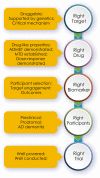The "rights" of precision drug development for Alzheimer's disease
- PMID: 31470905
- PMCID: PMC6717388
- DOI: 10.1186/s13195-019-0529-5
The "rights" of precision drug development for Alzheimer's disease
Abstract
There is a high rate of failure in Alzheimer's disease (AD) drug development with 99% of trials showing no drug-placebo difference. This low rate of success delays new treatments for patients and discourages investment in AD drug development. Studies across drug development programs in multiple disorders have identified important strategies for decreasing the risk and increasing the likelihood of success in drug development programs. These experiences provide guidance for the optimization of AD drug development. The "rights" of AD drug development include the right target, right drug, right biomarker, right participant, and right trial. The right target identifies the appropriate biologic process for an AD therapeutic intervention. The right drug must have well-understood pharmacokinetic and pharmacodynamic features, ability to penetrate the blood-brain barrier, efficacy demonstrated in animals, maximum tolerated dose established in phase I, and acceptable toxicity. The right biomarkers include participant selection biomarkers, target engagement biomarkers, biomarkers supportive of disease modification, and biomarkers for side effect monitoring. The right participant hinges on the identification of the phase of AD (preclinical, prodromal, dementia). Severity of disease and drug mechanism both have a role in defining the right participant. The right trial is a well-conducted trial with appropriate clinical and biomarker outcomes collected over an appropriate period of time, powered to detect a clinically meaningful drug-placebo difference, and anticipating variability introduced by globalization. We lack understanding of some critical aspects of disease biology and drug action that may affect the success of development programs even when the "rights" are adhered to. Attention to disciplined drug development will increase the likelihood of success, decrease the risks associated with AD drug development, enhance the ability to attract investment, and make it more likely that new therapies will become available to those with or vulnerable to the emergence of AD.
Keywords: Alzheimer’s disease; Biomarkers; Clinical trials; Drug development.
Conflict of interest statement
JC has provided consultation to Acadia, Accera, Actinogen, Alkahest, Allergan, Alzheon, Avanir, Axsome, BiOasis Technologies, Biogen, Bracket, Cassava, Denali, Diadem, EIP Pharma, Eisai, Genentech, Green Valley, Grifols, Hisun, Idorsia, Kyowa Kirin, Lilly, Lundbeck, Merck, Otsuka, Proclara, QR, Resverlogix, Roche, Samumed, Samus, Sunovion, Suven, Takeda, Teva, Toyama, and United Neuroscience pharmaceutical and assessment companies. JC is supported by Keep Memory Alive (KMA) and COBRE award from the NIGMC (P20GM109025).
HHF reports research support from the National Institutes of Aging: Alzheimer Disease Cooperative Study U19AG10483-26, Alzheimer's Disease Research Center P50 AG005131, Canadian Institutes of Health Research 201901CNA-417847-CAN-ABPI-32054/#254450, Brain Canada #4669, Biohaven Pharmaceuticals, Toyama Pharmaceuticals, UC Cures for Alzheimer's Disease Initiative BRD-16-501346 and development grant funding from Vivoryon (formerly Probiodrug), service agreements with Eisai Pharmaceuticals, Genentech/Roche Pharmaceuticals, Banner Health Institute, Samus Therapeutics, Merck Pharmaceuticals, Tau RX, Arkuda Therapeutics, and Samumed; speaker fees from World Events Forum, Medscape and Optum; and travel expenses from Axon Neurosciences, Alion Pharmaceuticals, Vivoryon (formerly Probiodrug), and Dominantly Inherited Alzheimer's Disease.
PS has received research support from Merck, GE Healthcare, Piramal, Alzheimer Nederland, Dioraphte, and Stichting VUmc Fonds and Stichting Alzheimer & Neuropsychiatrie; served as a consultant for AbbVie, Avraham, ARC, Janssen Research Foundation, MD Start, Nutricia, Takeda, Probiodrug, and Genentech and EIP Pharma; and received speaker fees from Piramal, Roche Diagnostics and GE Healthcare. He is the co-editor-in-chief of
Figures
References
-
- Alzheimer's Association. 2016 Alzheimer’s disease facts and figures. Alzheimer Dement. 2016;12(4):459–509. - PubMed
Publication types
MeSH terms
Substances
Grants and funding
LinkOut - more resources
Full Text Sources
Other Literature Sources
Medical



